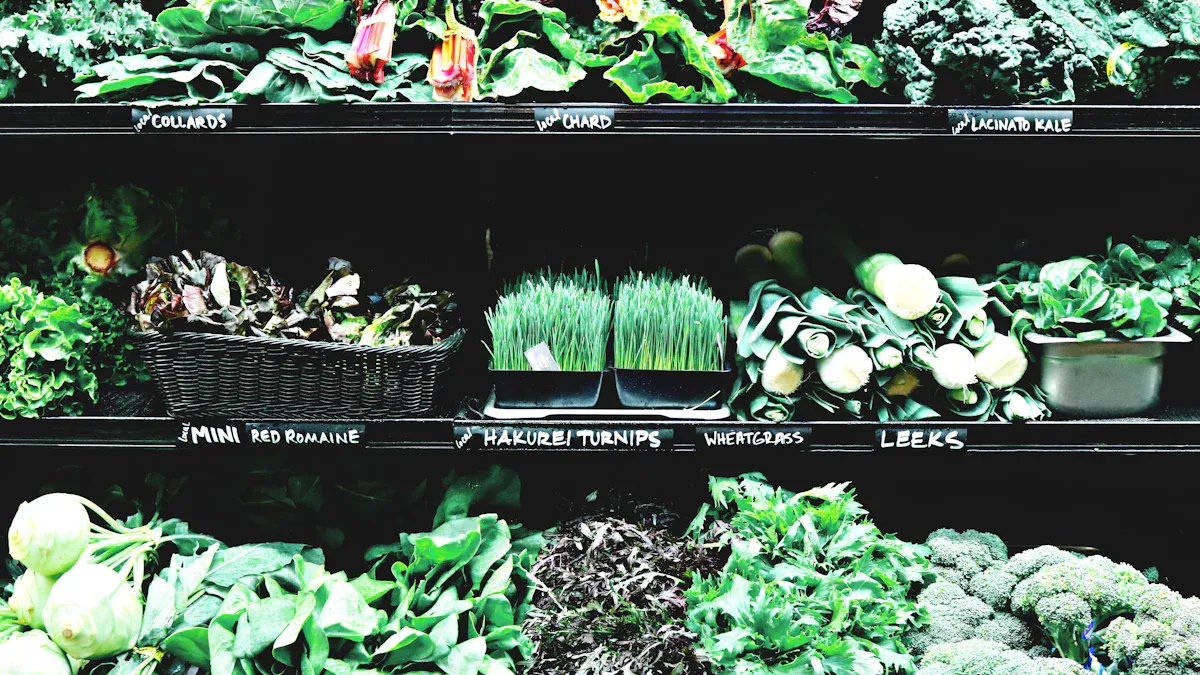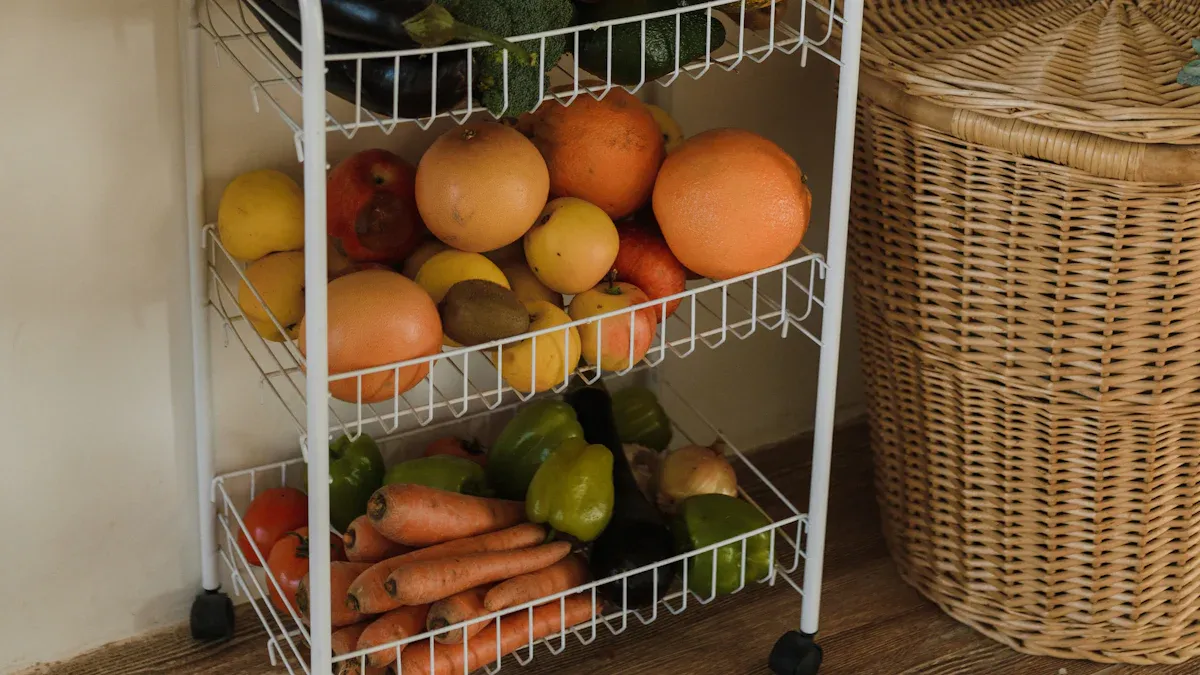How to Optimize Vegetable Storage with the Right Cold Storage Solution

Keeping vegetables fresh can be hard, but vegetable cold storage helps. Refrigerated containers keep food fresh by controlling temperature and moisture. They also stop bacteria from growing, which reduces spoilage. Good vegetable cold storage systems help you organize food better. This means less waste and more savings. Proper storage gives you fresher veggies, fewer store trips, and less food waste at home.
Key Takeaways
Cold storage keeps veggies fresh by controlling heat and moisture. This helps keep their flavor and feel the same.
Storing veggies right cuts waste and saves money. Fewer store trips mean more time to enjoy fresh food.
Pick the best cold storage for your needs. Think about size, energy use, and settings for different veggies.
Take care of your storage unit. Clean it often and check seals to keep veggies fresh and stop them from going bad.
Use smart tools to help. Smart fridges and sensors can check conditions and warn you of changes, stopping waste.
Why Cold Storage is Important for Vegetables
Keeping Vegetables Fresh and Tasty
Have you seen veggies lose crunch when left out? This happens because they need the right conditions to stay fresh. Cold storage keeps the temperature and moisture just right. It slows aging and keeps vegetables crisp and tasty. For example, refrigerated containers stop spoilage and keep food fresh longer. When you store veggies correctly, meals taste better, and less food goes to waste.
Making Vegetables Last Longer
Cold storage doesn’t just keep veggies fresh—it helps them last. By keeping a steady temperature, your produce stays good for longer. This means fewer store trips and more time to enjoy your veggies. Whether it’s spinach or carrots, proper storage keeps them fresh for weeks. Refrigerated storage stops bacteria and slows rotting. With the right setup, you save money and always have fresh food.
Reducing Waste and Spoilage
Spoiled veggies waste money and hurt the planet. Cold storage stops this by keeping your produce in great shape. Businesses use refrigerated containers to avoid spoilage and manage stock better. At home, cold storage helps you save food instead of throwing it away. Less waste means saving money and helping the environment. Plus, you’ll always have fresh veggies ready for cooking.
Key Factors to Think About for Vegetable Cold Storage
Temperature and Humidity Control
Temperature and humidity are very important for storing veggies. You need storage that keeps the right balance for freshness. If it’s too warm, veggies spoil fast. If it’s too cold, they freeze or lose texture. Humidity is also key. Leafy greens need high humidity to stay crisp. Onions, however, like dry conditions.
Modern cold storage units are built to handle this well. They use special cooling systems and insulation to keep things perfect. This stops spoilage and makes your veggies last longer. With the right storage, you’ll enjoy fresh vegetables for weeks.
Storage Size and Space Needs
Before picking a storage unit, think about how much space you need. Are you storing veggies for your family or a business? Too many veggies in one space can cause uneven cooling. This might ruin your food. But having too much empty space wastes energy.
Measure your area and plan your storage layout. Use stackable bins or shelves to save space and stay organized. A good setup helps you store veggies better without wasting energy or space.
Saving Energy and Cutting Costs
Saving energy helps the planet and saves you money too. Cold storage units can use a lot of power, so choose an energy-saving model. Look for features like LED lights, smart controls, and good insulation.
Energy-efficient units may cost more at first, but they save money later. They also lower your carbon footprint. A smart choice keeps your veggies fresh and your costs low.
Customization Options for Different Vegetables
Different vegetables need different storage conditions to stay fresh. Some like high humidity, while others need it dry. That’s why having a cold storage unit with adjustable settings is helpful. It lets you create the best environment for each vegetable.
For example, leafy greens like spinach and lettuce need moist air. Root vegetables like potatoes and onions prefer cooler, drier spaces. A good storage unit lets you change temperature and humidity for each section. This way, all your veggies stay fresh in one place.
Tip: Use separate sections in your storage unit for different veggies. This keeps them fresh and avoids mixing smells or moisture.
Some advanced units even have smart technology. These systems check conditions and adjust them automatically. You can also get alerts if something isn’t working right. This helps prevent spoilage and keeps your vegetables in great condition.
Security and Maintenance Features
Keeping your veggies safe and your storage clean is important. Look for storage units with security features like lockable doors. This stops people from taking your food without permission. It’s especially useful for businesses or large amounts of produce.
Regular cleaning is also necessary. Pick a unit that’s easy to clean, like one with removable shelves. Some units even clean themselves, saving you time and effort.
Note: Check for warranties or service plans when buying a storage unit. These can help with repairs and make your unit last longer.
By focusing on adjustable settings, safety, and easy cleaning, you’ll get the best storage. Your vegetables will stay fresh, and you’ll feel confident they’re stored properly.
Types of Cold Storage Solutions for Vegetables

Refrigerated Storage Containers
Refrigerated storage containers are great for keeping vegetables fresh. They are portable and work for small or big businesses. You can set them up in your yard or at a work site. These containers keep temperatures steady, which is very important for storing vegetables.
A big advantage of these containers is their flexibility. They can store many types of vegetables, like leafy greens or root crops. They also come in various sizes to match your needs. Whether you have a few boxes or a big harvest, they can handle it.
Tip: Set the temperature correctly before adding vegetables. This keeps them fresh and prevents spoilage.
These containers are also energy-saving. Many models now have better insulation and cooling systems to lower energy use. If you want a dependable and affordable option, refrigerated storage containers are a smart pick.
Walk-In Coolers
Walk-in coolers are perfect if you need more storage space. They are often used in restaurants, stores, and farms. These coolers give you plenty of room to organize vegetables, making them easy to find.
Walk-in coolers keep temperatures and humidity steady. This helps vegetables stay fresh for a long time. You can also adjust shelves to fit different vegetables. For example, leafy greens can go on top shelves, while root veggies can go on lower ones.
Note: Clean shelves and check the cooling system often to keep it working well.
Smart Fridges
Smart fridges are a modern way to store vegetables. They have features like temperature control, humidity settings, and phone apps. You can change settings from your phone to keep vegetables fresh.
Some smart fridges have separate sections for different vegetables. This lets you store veggies with different needs in one fridge. For example, carrots can go in a dry section, while spinach stays in a humid one.
Did you know? Smart fridges send alerts if the temperature changes. This helps stop spoilage and saves money.
Smart fridges are great for homes or small businesses that want easy and efficient storage. They cost more at first, but their advanced features make them worth it.
Insulated Storage Units
Insulated storage units are great for keeping vegetables fresh. They use strong insulation to keep the inside temperature steady. These units work well in extreme weather or for outdoor storage.
A big benefit of insulated units is saving energy. The insulation keeps the temperature stable, so the cooling system works less. This lowers electricity costs while keeping your vegetables fresh.
Tip: Choose units with thick insulation and tight seals. These stop air leaks and keep veggies fresh longer.
Insulated units come in different sizes to fit your needs. Whether you have a small amount or a big harvest, there’s a unit for you. Some even have shelves you can adjust to organize your veggies better.
Here’s a simple table showing what insulated units offer:
Feature | Benefit |
|---|---|
Strong insulation | Keeps temperature steady |
Tight seals | Stops air and moisture leaks |
Energy-saving | Lowers electricity bills |
Adjustable shelves | Makes organizing easier |
These units are also very durable. They can handle tough weather without breaking down. Cleaning them is easy, which keeps your veggies in a clean space.
Did you know? You can also use insulated units for fruits or dairy.
If you want a strong and energy-saving option, try insulated storage units. They keep vegetables fresh and save you money and time.
Tips for Optimizing Vegetable Storage
Keeping Vegetables Neat and Fresh
Organizing vegetables isn’t just about looking tidy—it keeps them fresh. Group similar vegetables together. For example, leafy greens go in one spot, root veggies in another. This helps you meet their specific storage needs. Use clear bins or stackable containers to save space and see everything easily.
Don’t overcrowd your storage. When veggies are packed tightly, air can’t flow well. This makes them spoil faster. In the fridge, put delicate veggies like spinach or lettuce in the crisper drawer. This drawer keeps the right humidity for fragile produce.
Tip: Add labels with dates to your containers. This helps you use older veggies first and avoid waste.
Checking Temperature and Humidity
Temperature and humidity are key to keeping veggies fresh. Most veggies like cool, moist air, but some, like onions, need it dry. Use tools like a thermometer and hygrometer to check these levels in your storage.
If you store fruits with veggies, keep them apart. Fruits like apples release gases that make veggies spoil faster. Adjust your fridge’s humidity settings to match your veggies’ needs. High humidity is good for greens, while low humidity works for peppers and squash.
Did you know? Small temperature changes can make veggies spoil faster. Keep it steady for longer freshness.
Using Technology for Smarter Storage
Technology can make storing veggies easier and better. Smart fridges let you control temperature and humidity with an app. Some even alert you if conditions change, stopping spoilage early.
Try vacuum-sealed bags or containers with sensors. These remove extra air and track freshness, helping veggies last longer. For bigger setups, automated cold storage systems are great. They adjust conditions based on the type of veggies stored.
Pro Tip: Use apps to track what’s in your fridge. They remind you to use veggies before they go bad, reducing waste.
Regular Maintenance and Cleaning Practices
Keeping your cold storage clean helps your vegetables stay fresh. Regular care makes your storage last longer and stops spoilage. Follow these simple steps to keep it in good condition:
Clean Shelves and Surfaces Weekly
Wipe shelves, bins, and surfaces with a gentle cleaner. This removes dirt, spills, and germs that can harm veggies. Use a soft cloth to avoid scratching the surfaces.Inspect Seals and Gaskets
Look at the door seals often. Broken seals let cold air out, spoiling veggies and wasting energy. Replace damaged seals quickly to keep the temperature steady.Defrost When Needed
If your unit isn’t frost-free, ice can block airflow. Defrost it when you see frost building up. Follow the instructions from the manufacturer for safe defrosting.Check Temperature and Humidity Sensors
Test sensors to make sure they work right. Broken sensors can mess up settings and ruin veggies. Fix or replace them if needed.Empty and Deep Clean Monthly
Take everything out once a month to clean deeply. Wash the inside with warm soapy water. Dry it well before putting veggies back to stop mold.
Pro Tip: Use natural cleaners like vinegar or baking soda. They’re safe for veggies and better for the environment.
Schedule Professional Maintenance
For big units, get a professional check-up every six months. Experts can find problems like leaks or motor issues that you might miss.
By doing these steps, your cold storage will work well. Your veggies will stay fresh, and you’ll save money by avoiding waste or repairs. 😊
Picking the right cold storage for vegetables is very important. It helps keep veggies fresh and saves you money. Look at things like temperature, size, and energy use to choose the best one. Whether it’s for home or business, think about what you need. With the right storage, your veggies stay fresh longer, and you waste less food. You’ll also save more money. Don’t wait—start improving your vegetable storage now!
FAQ
What is the best temperature for vegetables?
Most veggies stay fresh at 32°F to 50°F. Leafy greens like cooler temperatures. Root veggies, like potatoes, prefer around 45°F. Always check each vegetable’s specific needs.
Tip: Use a thermometer to keep the temperature steady for freshness.
Can fruits and vegetables be stored together?
No, it’s better to keep them apart. Fruits like apples and bananas release ethylene gas. This gas makes vegetables spoil faster. Store fruits and veggies in separate sections.
Did you know? Lettuce, carrots, and broccoli spoil quickly from ethylene gas.
How often should cold storage be cleaned?
Clean your storage weekly to remove spills and germs. Once a month, empty it for a deep clean. Wash surfaces with warm soapy water and dry them well. This stops mold and keeps veggies safe.
Pro Tip: Use vinegar as a natural, eco-friendly cleaner.
How should vegetables be organized in storage?
Group similar veggies by their storage needs. Leafy greens go in high-humidity drawers. Root veggies belong in low-humidity areas. Use clear bins or labels to stay organized.
Tip: Don’t overcrowd. Airflow helps keep veggies fresh longer.
Are energy-saving storage units a good choice?
Yes, they lower electricity bills and help the planet. Energy-efficient units use less power and save money over time. Look for features like LED lights and smart controls.
Did you know? Energy Star units can save up to 30% on energy use.
See Also
Effective Solutions for Storage Issues with Versatile Cold Storage
Utilizing Restaurant Cold Rooms to Overcome Storage Obstacles
Establishing a Cold Room to Preserve Fresh Produce

